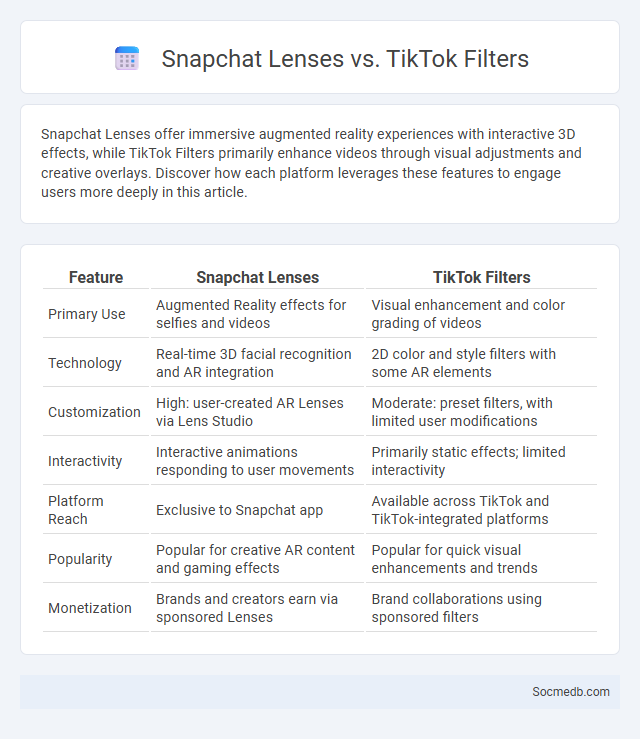
Photo illustration: Snapchat Lenses vs TikTok Filters
Snapchat Lenses offer immersive augmented reality experiences with interactive 3D effects, while TikTok Filters primarily enhance videos through visual adjustments and creative overlays. Discover how each platform leverages these features to engage users more deeply in this article.
Table of Comparison
| Feature | Snapchat Lenses | TikTok Filters |
|---|---|---|
| Primary Use | Augmented Reality effects for selfies and videos | Visual enhancement and color grading of videos |
| Technology | Real-time 3D facial recognition and AR integration | 2D color and style filters with some AR elements |
| Customization | High: user-created AR Lenses via Lens Studio | Moderate: preset filters, with limited user modifications |
| Interactivity | Interactive animations responding to user movements | Primarily static effects; limited interactivity |
| Platform Reach | Exclusive to Snapchat app | Available across TikTok and TikTok-integrated platforms |
| Popularity | Popular for creative AR content and gaming effects | Popular for quick visual enhancements and trends |
| Monetization | Brands and creators earn via sponsored Lenses | Brand collaborations using sponsored filters |
Introduction to AR Effects: Snapchat Lenses vs TikTok Filters
Snapchat Lenses and TikTok Filters both revolutionize social media engagement by offering immersive augmented reality (AR) effects that enhance user interaction and creativity. Snapchat Lenses provide real-time transformations using facial recognition technology, making your selfies dynamic and expressive, while TikTok Filters focus on overlay effects and thematic visuals that complement video content. Understanding the distinct capabilities of these AR tools helps you choose the right platform to amplify your social media presence and create captivating content.
Overview of Snapchat Lenses Features
Snapchat Lenses use augmented reality to transform your selfies and surroundings with dynamic animations and effects, enhancing user engagement through real-time interaction. These features include face tracking, 3D objects, and interactive games, making digital communication more immersive and creative. You can customize your snaps using a vast library of trending and location-based lenses, keeping your content fresh and engaging.
What Are TikTok Filters and Lenses?
TikTok filters and lenses are augmented reality (AR) effects that users apply to enhance videos by altering their appearance, adding animations, or creating immersive visual experiences. These tools leverage computer vision technology to track facial features or environmental elements, enabling real-time transformations that boost engagement and creativity. Popular TikTok filters can include beauty enhancements, face distortions, and thematic visual overlays that are integral to viral content and trend participation.
Creation Tools: Snapchat Lens Studio vs TikTok Effect House
Snapchat Lens Studio offers an advanced platform for creating augmented reality experiences with detailed 3D modeling and AI-driven capabilities, ideal for developers seeking intricate user engagement. TikTok Effect House emphasizes user-friendly tools and seamless integration with its massive content ecosystem, enabling creators to design interactive effects that leverage trending challenges and viral potential. Both platforms provide robust analytics, but Lens Studio focuses more on AR complexity while Effect House prioritizes social virality and ease of use.
User Experience: Navigating Lenses and Filters
Social media platforms enhance user experience by offering intuitive navigation through diverse lenses and filters that personalize content creation and engagement. Advanced algorithms prioritize user preferences, enabling seamless access to tailored visual effects that boost creativity and expression. Optimized interfaces reduce friction, ensuring smooth interactions and higher satisfaction during content sharing and consumption.
Customization: Personalizing AR Effects on Both Platforms
Customization options for personalizing AR effects on both Snapchat and Instagram empower you to create unique and immersive social media experiences. Advanced tools enable tailoring filters and interactive elements using facial recognition, location data, and user preferences. Enhancing engagement through personalized AR content drives higher user retention and deeper connections across platforms.
Popularity & Trends: Viral Lenses and Filters
Viral lenses and filters on platforms like Instagram and Snapchat significantly boost user engagement by enabling creative self-expression and interactive experiences. These digital effects harness augmented reality technology, often trending rapidly through influencer endorsements and user-generated content, amplifying their popularity across diverse demographics. Marketers leverage viral filters to increase brand visibility and drive social media campaigns, capitalizing on real-time trends and the viral nature of shareable visual content.
Monetization and Brand Opportunities
Social media platforms offer diverse monetization avenues such as sponsored content, affiliate marketing, and direct product sales, enabling creators to generate substantial revenue streams. Brands leverage these platforms for targeted advertising, influencer partnerships, and real-time customer engagement, significantly enhancing market reach and consumer loyalty. Advanced analytics and algorithm-driven recommendations further optimize ad spend and content strategies, maximizing return on investment for both individuals and companies.
Privacy and Safety Considerations
Protecting your personal information on social media platforms is essential to maintain privacy and security online. Use strong passwords, enable two-factor authentication, and regularly update privacy settings to control who can view your content. Be cautious about sharing location data or sensitive details to prevent identity theft and reduce the risk of cyberbullying or unauthorized access to your accounts.
Future Innovations in AR Lenses and Filters
Future innovations in AR lenses and filters are set to revolutionize social media by integrating advanced machine learning with real-time environmental mapping, delivering hyper-realistic and interactive experiences. Enhanced depth sensing and facial recognition technologies enable personalized filters that adapt dynamically to user expressions and surroundings, increasing engagement and immersion. Major platforms such as Instagram and Snapchat are investing heavily in AR SDKs and cross-platform compatibility to support seamless, AI-driven content creation and sharing.
 socmedb.com
socmedb.com